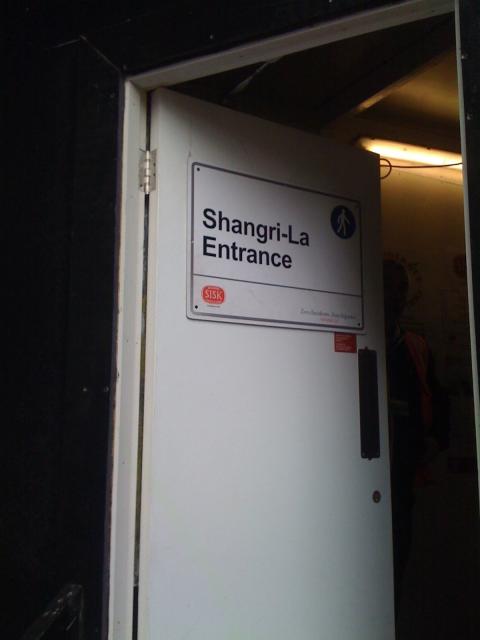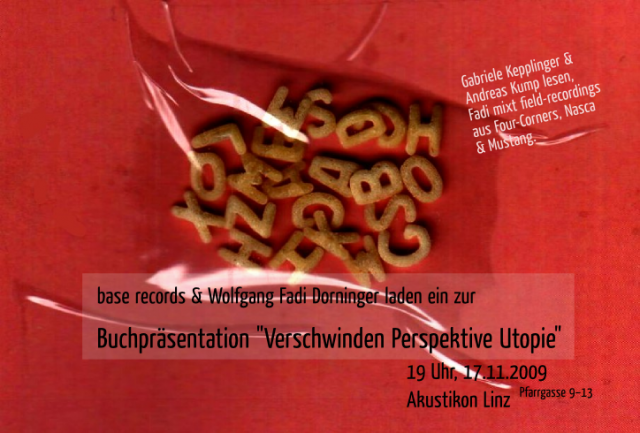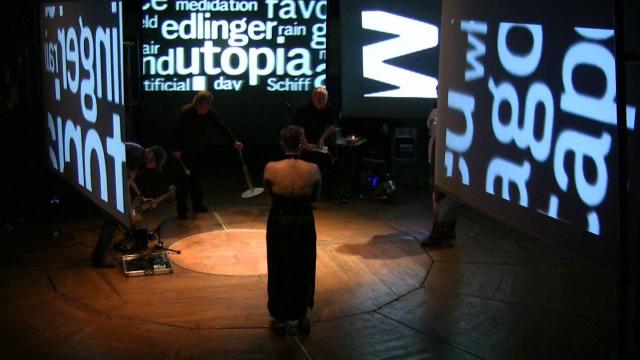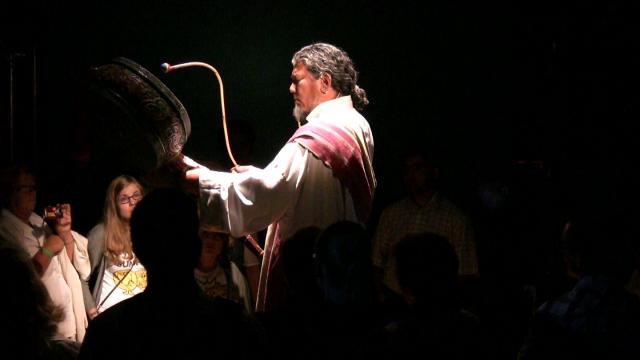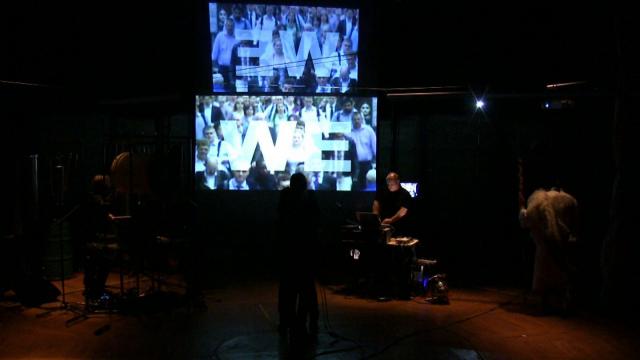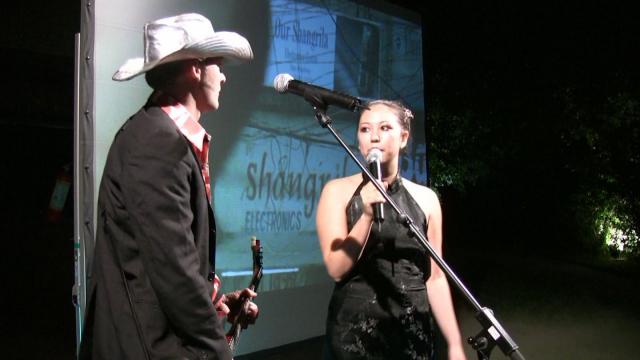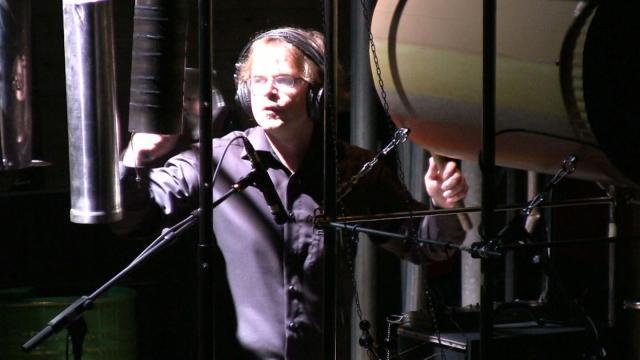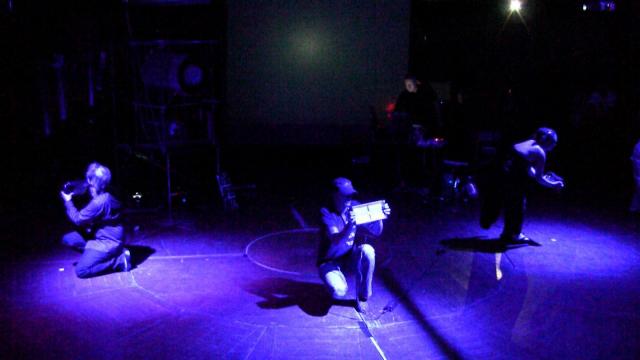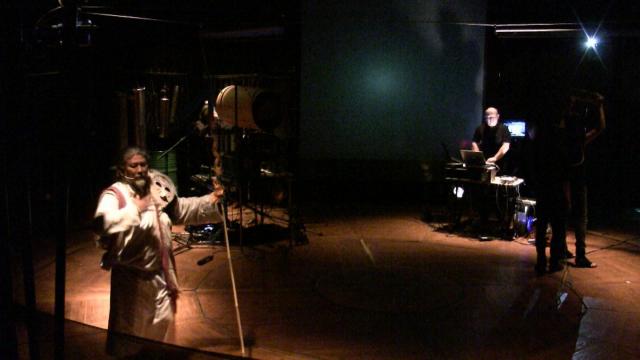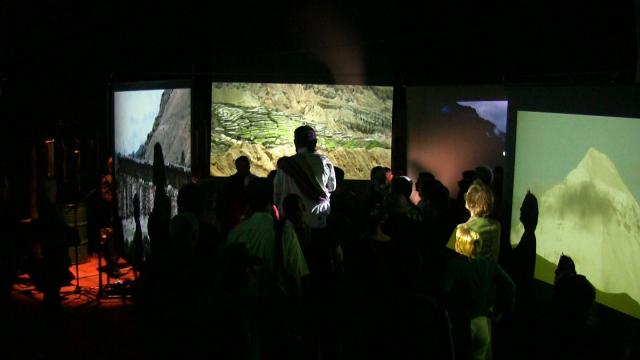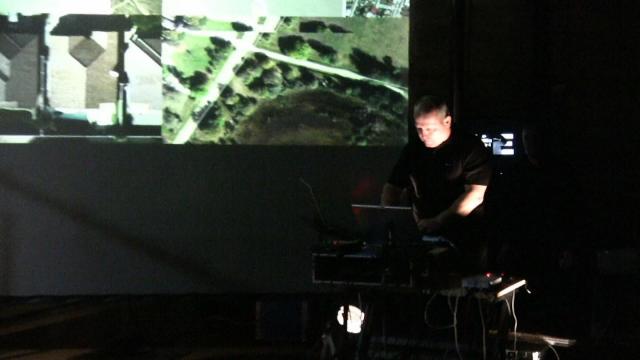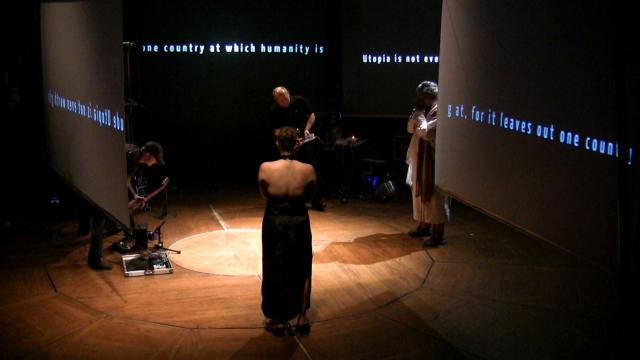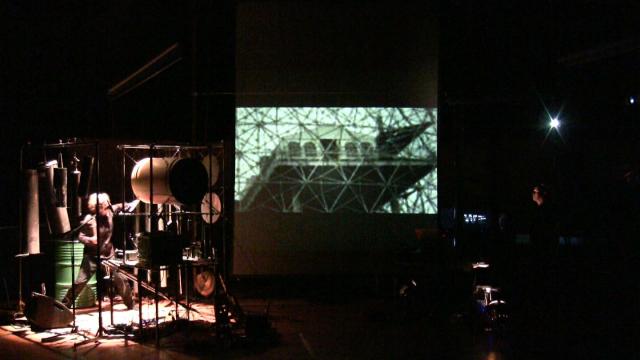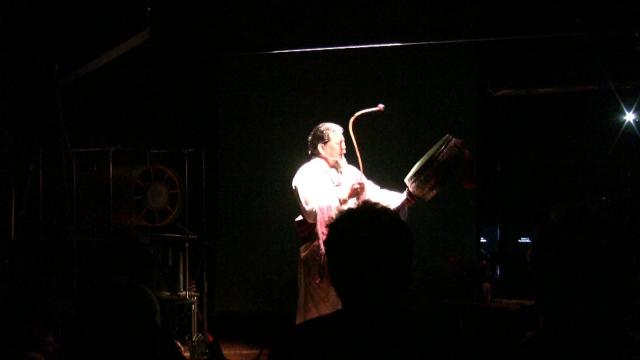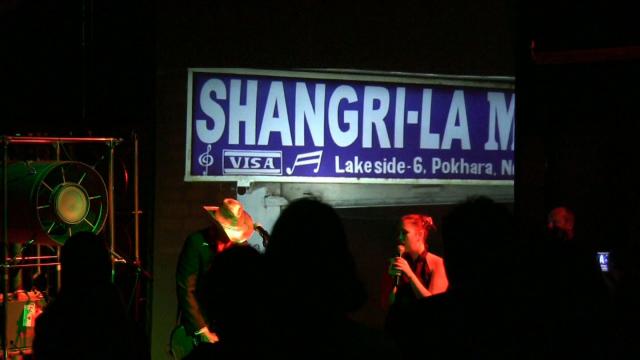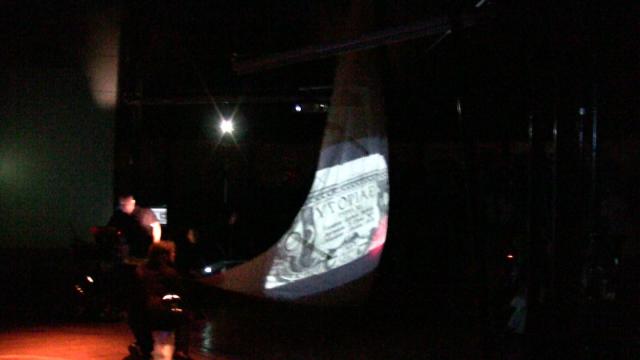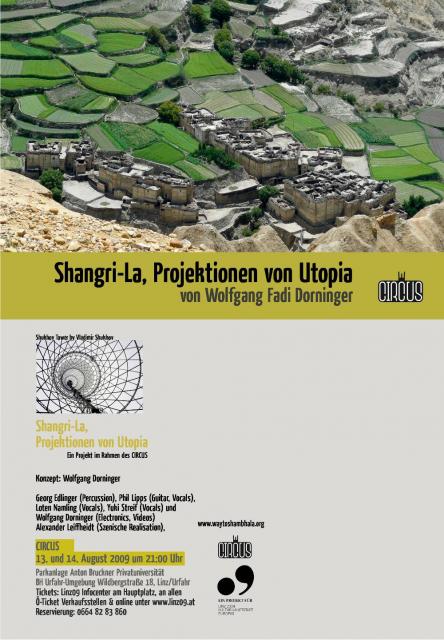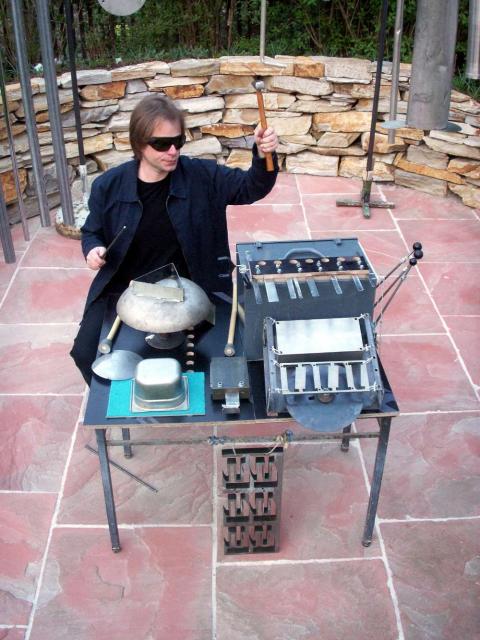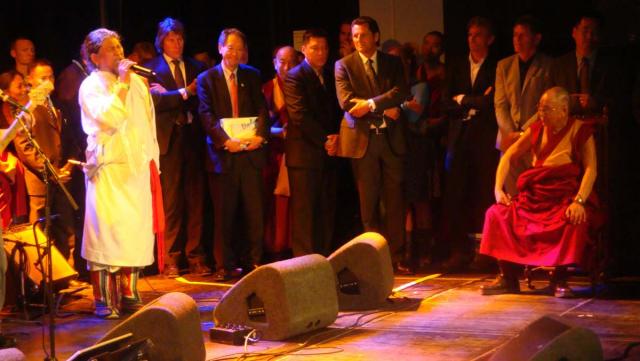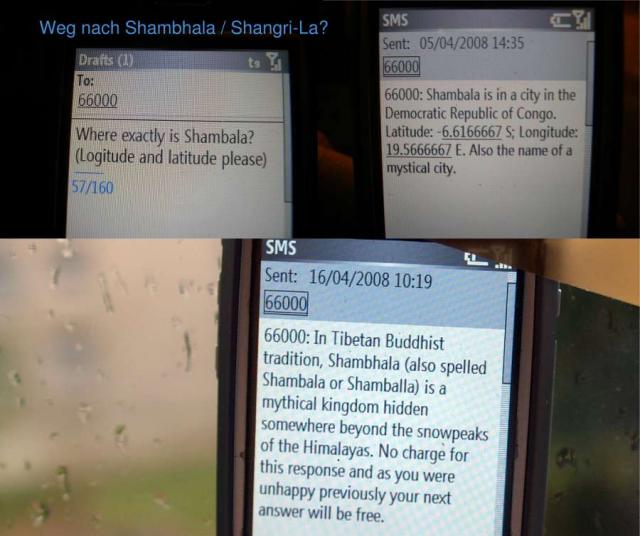Filmmuseum Wien: Utopie und Korrektur
Utopie und Korrektur - Sowjetisches Kino 1926-1940 und 1956-1977 / Utopia and Correction Soviet Cinema, 1926–1940 and 1956–1977
Vom 13. Oktober bis 30. November 2017 präsentiert das Filmmuseum folgende File zum Thema: / From October 13th till November 20th 2017 the Austrian Filmmuseum will present following films:
Filmauswahl | Film Selection
Šestaja čast' mira (Ein Sechstel der Erde / A Sixth Part of the World)1926, Dziga Vertov
235 000 000 1967, Uldis Brauns
General’naja linija / Staroe i novoe (Die Generallinie / Das Alte und das Neue // The General Line / Old and New) 1926–29, Sergei Eisenstein & Grigorij Aleksandrov
Tugoj uzel (Fester Knoten / The Tight Knot) 1956, Michail Švejcer
Kruževa (Die Spitze / Lace)1928, Sergej Jutkevič
Vesna na Zarečnoj ulice (Frühling in der Zarečnaja-Straße / Spring on Zarechnaya Street) 1956, Marlen Chuciev & Feliks Mironer
Putevka v žizn' (Der Weg ins Leben / Road to Life) 1931, Nikolaj Ėkk
Vtoraja popytka Viktora Krochina (Viktor Krochins zweiter Versuch / The Second Attempt of Viktor Krokhin) 1977, Igor' Šešukov Odna (Allein / Alone) 1931, Grigorij Kozincev & Leonid Trauberg
Strannye ljudi (Seltsame Menschen / Strange People) 1969, Vasilij Šukšin
Dela i ljudi (Die Taten und die Menschen / Men and Jobs) 1932, Aleksandr Mačeret
Vremja, vpered (Zeit, voran! / Time, Forward!) 1965, Michail Švejcer & Sof’ja Mil'kina
Garmon' (Die Ziehharmonika / Accordion) 1934, Igor' Savčenko
Karnaval'naja noč' (Karnevalsnacht / Carnival Night) 1956, Ėl'dar Rjazanov
Letčiki (Die Flieger / The Pilots) 1935, Julij Rajzman
Kryl'ja (Flügel / Wings)1966, Larisa Šepit'ko
U samogo sinego morja (Am blauesten aller Meere / By the Bluest of Seas)1935, Boris Barnet
Čelovek idet za solncem (Der Sonne entgegen / Following the Sun) 1961, Michail Kalik
Semero smelych (Die sieben Kühnen / Seven Courageous) 1936, Sergej Gerasimov
Neotpravlennoe pis'mo (Ein Brief, der nie ankam / The Unsent Letter) 1959, Michail Kalatozov
Novaja Moskva (Das Neue Moskau / New Moscow) 1938, Aleksandr Medvedkin & Aleksandr Olenin
Ijul’skij dožd’ (Juli-Regen / July Rain) 1966, Marlen Chuciev
Člen pravitel'stva (Mitglied der Regierung / Member of the Government) 1939, Aleksandr Zarchi & Iosif Chejfic
Prošu slova! (Ich bitte ums Wort / I Want the Floor)
1975, Gleb Panfilov
Muzykal’naja istorija (Eine musikalische Geschichte / A Musical Story) 1940, Aleksandr Ivanovskij & Gerbert Rappaport
Beregis' avtomobilja (Vorsicht, Autodieb! / Beware of the Car) 1966, Ėl'dar Rjazanov
Timur i ego komanda (Timur und sein Trupp / Timur and His Team) 1940, Aleksandr Razumnyj
Spasite utopajuščego (Rettet den Ertrinkenden / Save the Drowning Man) 1967, Pavel Arsenov
Vesennij potok (Frühling des Lebens / Spring of Life)
1940, Vladimir Jurenev
Ključ bez prava peredači (Ein Schlüssel, den man nicht weitergeben darf / The Key That Should Not Be Handed On) 1976, Dinara Asanova
Info Deutsch Filmmuseum Wien
Info Englisch Filmmuseum Wien
Augustinerstraße 1, 1010 Wien (im Gebäude der Albertina)
kontakt@filmmuseum.at
T +43 | 1 | 533 70 54
F +43 | 1 | 533 70 54 DW 25
Öffnungszeiten
Büro: Montag bis Donnerstag von 10 bis 18 Uhr | Freitag von 10 bis 13 Uhr
Bibliothek: Montag und Donnerstag von 12 bis 18 Uhr
Abendkasse: Jeweils eine Stunde vor Beginn der ersten Vorstellung
Without Reality There Is No Utopia - Exhibition San Francisco
Without Reality There Is No Utopia
(Text from e-flux: http://www.e-flux.com/announcements/without-reality-there-is-no-utopia/ )
February 15–June 2, 2013
Yerba Buena Center for the Arts
701 Mission Street
San Francisco CA 94103
Behind the phrase that lends this exhibition its title there are two thinkers: Jean Baudrillard and Andreas Huyssen. The former defined simulation as the creation of something that “has no relationship to any reality whatsoever,” and therefore predicted the replacement of “the real” by “the virtual.” Huyssen picks up where Baudrillard left off, positing that, since reality has been lost and replaced by its simulacrum, utopia cannot exist. Hence the title, “if there is no reality, there can be no utopia.” In other words, in the age of simulacra and virtual reality, the disappearance of the real also entails the end of the utopian.
In the age of information, actual reality has been supplanted by virtual reality, computer simulation and false narratives. Since the concept of utopia is based on the improvement of reality, the disappearance of the real also signals the end of utopia. Without Reality There Is No Utopia illustrates this premise by examining false narratives that masquerade as truth; the collapse of Communism in the 1980s; the recent financial crisis, which heralds the demise of capitalism; the contradictions inherent in geopolitics; and the explosion of democratic uprisings that rebounded around the world. The exhibition, organized into two asymmetrical sections, includes work by twenty-two international artists in photography, video, drawing, painting, collage and more.
The first is The Description of the Lie, a skeptical introduction to the systems, which fabricate the simulacra of the real. In this section, the artists focus on how truth has been replaced by media-constructed false narratives. Judi Werthein‘s work portrays life in a settlement in a region of Chile peopled entirely by Germans exiled from their country after World War II; and Dora García fictionalizes the paranoid state of surveillance generated by the Stasi in the former East Germany. Other artists in this section are Rirkrit Tiravanija and Lene Berg.
The second section bears the title Collapses and is divided into four sub-sections: communism, capitalism, geopolitics and democracy. As Huyssen aptly put it, “Utopia never dies alone. It takes its counter-utopia down with it.” Therefore, when communism falls it takes capitalism down, and as capitalism collapses it drags democracy along with it, since the latter decided to cast its lot in with the former. At the same time, the expansive system that characterizes capitalism also implies its geopolitical implosion. It therefore seems that we should seriously consider the demise of utopia as the great problem of our time.
Artists in The Collapse of Communism examine the conditions leading up to, and the aftermath of, the fall of Communism. The Russian collective Chto Delat? (What is To Be Done?) encourages the viewer to critically engage with the events that lead to the demise of the Soviet system; paintings by Manolo Quejido were inspired by a trip to Cuba, where he asks, “What can we do right now with our desire for revolution?” and Ciprian Mureşan considers the paradoxes of history and memory from a post-Communist perspective.
The Collapse of Capitalism focuses on the effects of the 2008 world financial crisis, with the premise that this was the inevitable result of a system based on consumerism, waste and the depletion of the planet’s resources. SUPERFLEX Collective‘s humorous parody The Financial Crisis ironically suggests that the crisis is an illness that can be cured through hypnosis; and El Roto‘s cartoons, which mix irony, dark humor and sarcasm, create a stark portrait of the current situation in Spain. Other artists in this section are Daniel García Andujar, Jan Peter Hammer and Katya Sander.
The artists in The Geopolitical section examine the influences of colonialism and the West on recent geopolitical uprisings. Through a collection of posters, Zeina Maasri documents the civil war in Lebanon between 1975 and 1990; and in his drawings Fernando Bryce depicts colonial practices and their “civilizing” discourses. Other artists in this section are Ignasi Aballí, Zhou Xiaohu and Federico Guzmán.
The Democracy section traces the effects of technology on communications, privacy and public assembly and their impact on democracy. Ed Hall‘s banners depict the micro-history of recent social struggles in England; Artur Żmijewski‘s videos of intentional public gatherings in various cities—Belfast, Berlin, Strasbourg, the West Bank, and Warsaw—feature playful and celebratory events; Oliver Resslerinterviews philosophers, politicians, activists and concerned citizens, asking What is Democracy?; andCarlos Motta‘s photographs feature political graffiti on the walls of various Latin American cities.
Without Reality There Is No Utopia is organized by the Centro Andaluz de Arte Conteporaneo in Seville, Spain, where it was originally presented in 2011. Curators are Alicia Murría, Mariano Navarro and Juan Antonio Álvarez Reyes.
For more information on Without Reality There Is No Utopia, artist bios, and visitor information, click here.
Lissitkzy – Kabakov, Utopia and Reality
Lissitkzy – Kabakov,
Utopia and Reality
1 December 2012 – 28 April 2013
Opening: Saturday, 1 December 2012, 3pm
Van Abbemuseum
Bilderdijklaan 10
Eindhoven, The Netherlands
T +31 (0)40 238 1000
info@vanabbemuseum.nl
Press release:
The Van Abbemuseum asked the artists Ilya (b. 1933) and Emilia (b. 1945) Kabakov to organise an exhibition of their work together with that of El Lissitzky (1890–1941), as guest curators. For the Lissitzky – Kabakov exhibition, they made an extensive selection from their own work and that of Lissitzky. It is the first time that the oeuvres of these famous 20th-century Russian artists are being presented together. Bringing together Lissitzky and the Kabakovs completes the circle which started with the revolutions in the early years of the twentieth century and finished with the upheavals of 1989. The confrontation between early Soviet art and that of the later Soviet era presents opportunities for a better understanding of the art and culture of the intervening period. In addition to works from the collection of the Kabakovs and the Van Abbemuseum, there will be loans from the Tretyakov Gallery in Moscow, the Guggenheim Museum in New York and Centre Pompidou in Paris, as well as from a number of private collections. Some of the Kabakovs’ installations have also been recreated for this occasion.
Two sides of the Soviet coin
Lissitzky’s enthusiasm for the revolution and his involvement in the new social order is present everywhere in the exhibition. In contrast, one constantly comes across the Kabakovs’ melancholic but also humorous representation and interpretation of the conditions of the late Soviet era. The mother country of both the artists had become a place where the rhetoric of progress had run aground on the everyday reality of life in that society. Nevertheless, it proved possible to re-emerge from this twilight zone.
Publication
There is a detailed catalogue available in Dutch and English for the exhibition, with an in-depth article by the Kabakov expert Professors Boris Groys, an imaginary interview with Lissitzky by Professor John Milner, an expert in avant-garde Russian art, and an interview with Ilya and Emilia Kabakov by the artist Anton Vidokle. All the works in the exhibition are shown in colour, arranged in accordance with the themes in the exhibition. Finally, the book contains an illustrated image biography of the artists.
Guest curators
Ilya and Emilia Kabakov
Curator Van Abbemuseum
Charles Esche
Project leader Van Abbemuseum
Willem Jan Renders
The exhibition is part of NLRF2013, the Dutch – Russian year and is scheduled to travel to the Hermitage in St. Petersburg and the Multimedia Art Museum (MAMM) in Moscow in 2013.
For more information on Lissitzky – Kabakov, Utopia and Reality you can visit www.vanabbemuseum.nl
Or follow us on Facebook and Twitter.
Source: http://www.e-flux.com/announcements/lissitkzy-%E2%80%93-kabakov-utopia-a...
SUPERSTADT! Utopia, Utopia!
A symposium on the future of the city
SUPERSTADT! Utopia, Utopia!
Thursday, October 18th, 2012 | 10:00-19:00
University of Art and Design Linz, 4010 Linz, Kollegiumgasse 2, 1st floor, Audimax
ADMISSION FREE!
+ + +
PROGRAMME
10:00 Opening
10:15 SABINE POLLAK | Vienna/Linz
11:00 MAGNUS LARSSON | Stockholm
11:45 AMID.cero9 | Madrid
14:00 SIBYLLE HAMANN | Vienna
14:45 LIAM YOUNG : Tomorrow's Thoughts Today | London
16:00 LARS SCHMID : red park | Vienna
16:45 JAN TABOR | Vienna
17:30 MELISSA LOGAN & ALEX MURRAY-LESLIE : Chicks on Speed | Hamburg
19:00 Buffet & Drinks, SUPERPARTY!
+ + +
Utopia, Utopia!
Floating cities, artificial mountains, vertical farms and flying houses: Today, utopias are in fashion again. Like the early utopias, they respond to collapsing systems, are built on inhospitable territories and conceive structures freed from social constraints and gravity. Utopias have always fulfilled a multi-functional role. They transcend reality and permit its vehement criticism at the same time. In 1930, Buckminster Fuller predicted cosmic bankruptcy and offered houses using space technology in reply. The 1960s exhibited an ironic remodelling of technological progress, and the 1970s, in response to any economies whatsoever, an architecture of maximum pleasure gain. Towards the end of the 20th century, architectonic utopias increasingly disappeared, making room for a construction boom and a new pragmatism. Even without utopias, new cities grew, demanding fast concepts in global architecture. Utopic thinking was posited to be obsolete.
Today's utopias may have lost the criticism of the system, then again they are still meaningful. Climate change, disasters and social inequalities cannot be solved in the now, making a drifting-off into possibilities plausible. How to deal with drought, floodings and mountains of garbage? What to do in the future, with the cities, the landscape, the deserts and the sea?
Utopia, Utopia! congregates radical and questioning counterworlds of the yet impossible to build for tomorrow's supercity. Architects show insane buildings, urbanists the city in a hundred years from now, artists present subversive counter models, men and women of letters enter fictional spaces and philosophers talk about the sense or nonsense of utopias.
+ + +
CURATOR: Sabine Pollak, Architecture | Urbanism, University of Art and Design Linz
MODERATION: Angelika Fitz
ORGANISATION: Anja Aichinger
Utopia Lost: Why Digital Music Has Failed Us
Annie Licata is rigth when she writes for Hypebot.com "There’s no work involved in consuming music anymore, whether it be finding or listening or sharing — there’s no reward. Technology has stolen gratification in music."
Read the whole article at Hypebot.com.
Utopia & Contemporary Art
ARKEN Museum of Modern Art releases new book: "Utopia & Contemporary Art"
New book release:
Utopia & Contemporary Art
Winter 2012, English
176 pages, 64 ill., hardcover
ISBN 978-3-7757-3281-9
http://www.hatjecantz.de/controller.php?cmd=detail&titzif=00003281
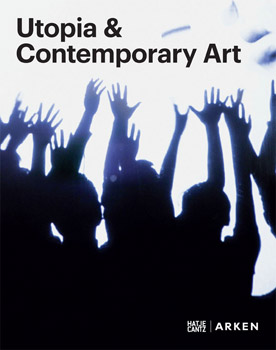
The revival and reinterpretation of utopia in contemporary art
Utopia has become a controversial concept, spanning the field between the belief in an ideal society and the dystopian nightmare. Within the last decade, the contemporary art scene has witnessed a return of utopia and utopian thinking. Whether detectable as an impulse, critically reassessed as a concept, or cautiously or daringly articulated in a specific vision—utopia continues to matter. This publication investigates the meanings of utopia in contemporary art. Theorists, critics, and curators discuss the different ways of thinking and performing utopia in contemporary art from a broad range of angles. The essays explore the current relevance of utopia as well as how people in different societies live, think, act, and imagine. The two parts, Utopia Revisited and Utopian Positions, provide both a theoretical backdrop for the reformulations of utopia in contemporary art as well as examinations of specific utopian stances in connection with the three-year utopia project at ARKEN Museum of Modern Art and solo shows by Qiu Anxiong, Katharina Grosse, and Olafur Eliasson.
Exhibition schedule: ARKEN Museum of Modern Art, Copenhagen, ongoing
http://www.arken.dk
The world in 1987 (as seen from 1960)
A friend just sent this to me. The Nehru hats are to prevent hair from falling onto the electrons.
CUMA Contemporary Utopia Management

I always get emails by ¨cˇu'm„a* presenting their projects. It is about time to link to their site and activities.
¨cˇu'm„a*is a non-profit contemporary art organization, aiming to activate urban and rural communities by creating contemporary art projects and acting as a mentor for art organizations and initiatives. ¨cˇu'm„a* is based in Istanbul, Turkey.
Their currant project Istanbul - Amsterdam Audio Tours is an attempt to draw different personal maps of metropolises, focusing on the subjective perception of urban environments and the impact of these environments on shaping this perception. The 2010 edition of the project was conceived with the idea to execute an audio tour prepared for a certain city, in another one. To what extent would these metropolises be similar? Could it be possible to make an audio tour for Istanbul that would fit another European city (and vice versa)? What would the complementary elements in both cities be? Would these be the immigrants, the sounds, some stories, a feeling or just a coincidentia oppositorum?
Call for proposals: networked-utopias-and-speculative-futures
The Fibreculture Journal calls for proposals for a special issue:
"Networked Utopias and Speculative Futures"
Editors: Susan Ballard, Zita Joyce and Lizzie Muller
Call for Proposals — Deadline: February 20, 2011
detailed information at Turbulance: http://turbulence.org/blog/2010/11/20/networked-utopias-and-speculative-...
or
at Fibreculture Journal: http://fibreculturejournal.org/
Utopias everywhere Pt.III
"Utopia is not a destination, but a direction"!
Steve Lambert on Utopia at Transmediale 10
Steve Lambert on Utopia at Transmediale 10 from Steve Lambert on Vimeo.
Utopias everywhere Pt.II
The MIT Visual Arts Program hosts a cross-disciplinary lecture series that includes speakers from art, architecture, urbanism and technology from around the world. These speakers will start a discourse to imagine tomorrow's urban living conditions.
Clips - Part1 - Scene3 & 5!
"Shangri-La, Projektionen von Utopia"
Scene 3: "Beyul Pemakö
Scene 5: "We / I"
Live at Circus/Linz09 - 14.8.2009
Video filmed by Gabriele Kling-Dorninger
Vocals: Loten Namling
Vocals: Yuki Streif
Guitar & vocals: Phil Lipps
Percussion: Georg Edlinger
Electronics: Wolfgang Dorninger
Scenic Realisation: Alexander Leiffheidt
More scenes will be uploaded soon.

You are missing some Flash content that should appear here! Perhaps your browser cannot display it, or maybe it did not initialize correctly.
Boxed: "Verschwinden Perspektive Utopie"
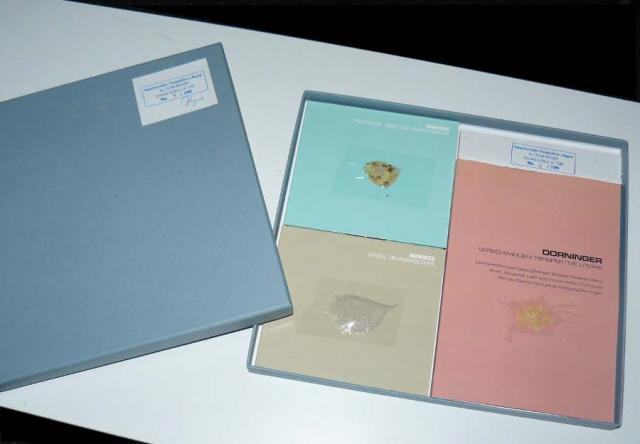 Boxed: Verschwinden Perspektive Utopie: limited edition of 100!
Boxed: Verschwinden Perspektive Utopie: limited edition of 100!
base records is proud to present "Verschwinden Perspektive Utopie" in a pleasure box. Included is a CD, DVD and book in a limited edition of 100.
You can buy this very nice package online via base shop, at my favorite book store Buchhandlung Alex (Hauptplatz 17, Linz Austria) or at the Linz09 Infocenter (Hauptplatz5).
Dorninger started his trilogy 2001 with "Hisatsinom, über das Verschwinden" (CD). 2005 "Nasca, on perspective" was released as a DVD and finally "Shangri-La, Projektionen von Utopia" was released as book.
Performances of all three pieces took place at festivals like Festival 4020, T-U-B-E München, OK Centrum für Gegenwartskunst, La Casa Encendida (Arco Madrid), FILE Rio, Linz09 Kulturhauptstadt Europas.
Dorninger "Verschwinden Perspektive Utopia"
 Bookcover "Verschwinden Perspektive Utopie"
Bookcover "Verschwinden Perspektive Utopie"
Dorninger's book "Verschwinden Perspektive Utopie" (base records 0809-15) on all three topics of the trilogy "Hisatsinom, über das Verschwinden", "Nasca, über die Perspektive" and "Shangri-La, Projektionen von Utopia" is now available at base shop or at BOD
Authors: Brigitte Felderer, Christiane Richter, Gerhard Dirmoser, Georg Edlinger, Mario Koch, Alexander Leiffheidt, Robert Misik, Dietrich Schulze & Wolfgang Dorninger.
Price 19,90.-€
The Circus moves on
Last night's show was absolutely spot-on - and we were luckier with the weather this time, so Yuki and Phil could play a fantastic pop intro outside in front of the tent. Watch this space for a video!
The tent was packed again. I don't have the box office figures yet, but by the looks of it we pretty much sold out for both shows.
So, this is it now. The Circus moves on, and we're all back on the road. Thank you Linz. It's been a great week, and a great show. I'm really pleased with what we achieved.
PS: actually, the Circus doesn't move on yet - it'll continue to be in Linz until 30th August. Have a look at the Circus programme for some other exciting events.
Ta-da!
We've made it!
I'm still not entirely sure how - changing light cues an hour before doors opened while Fadi smashed up his brand new Western Digital Players (who were doing anything but that) and brought in Linux and Mac machines to the rescue, god knows where from. All that after four hours of sleep. If you ever thought doing a Fringe show was bad, try doing a multimedia show.
But it all came together in the end - Phil and Yuki performed an awesome opening Shangri-La medley that drew the crowds into the space, then Loten sang his first song and enchanted everyone - George gave a fantastic performance both at the sail and in his crazy flying percussion machine, while Fadi kept it all together with his magic sounds and videos.
I'm really pleased with the way everything turned out, and with the great team we put together in so few days: Milan our light designer, Roland the sound engineer, Ingo the video engineer, our great stage crew Verena, Maxi and Pascal, George who built the rigging, Joseph the percussion engineer - not least Iris, the production manager, and especially Gabi, without whom we all would have been utterly lost. Everyone worked great together and contributed with their own ideas and creativity to making it all happen. And the people loved it.
Good stuff.
Nightshift
We've got our get in tonight - starting at half nine, after the show that was in the space before us had left. Nobody's exepecting to go home before 3 in the morning... but things are going ok.
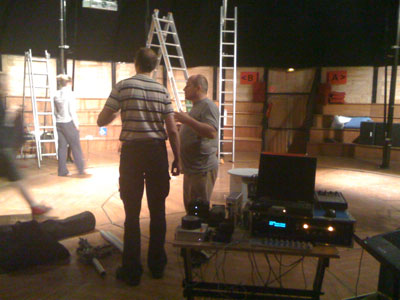
Rehearsals
...are going well.
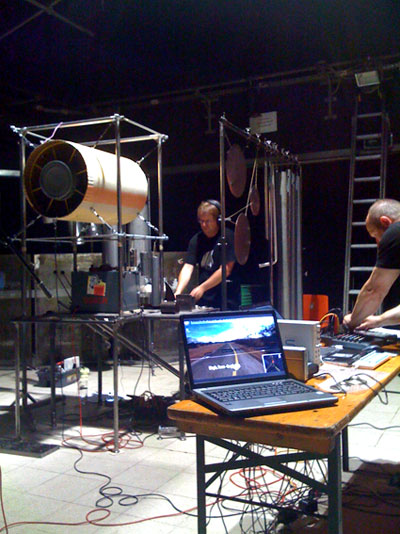
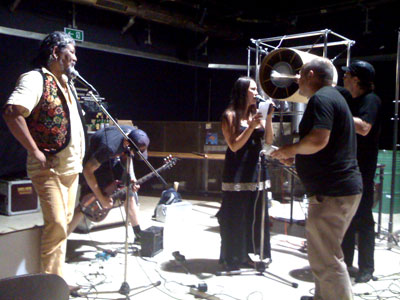
Two days to go...
Two days to go until we will reveal the Way to Shambhala to you. We are very excited. Fadi is just adding some finishing touches to the masterpiece, while I fuff around with the website and tidy up some loose ends.
This is your last chance to tell us your way to Shambhala - so register now and upload yours!
Oh, and don't forget to book your ticket. No ticket, no utopia. It's that simple.

Visit our friends at The Utopian
There are online mags aplenty on the world wide web. What sets this one apart is its distinctive mix of rather superb short fiction pieces, fresh perspectives on the current state of the world and some other thing they call "Talking Heads".
About the latter all we can say is that apparently it does not require editor and founder Yascha to have a preparatory shave. Nor comb his hair. Nor even get out of bed properly.
Check it out:
The Shangri-La team is complete!
I am glad to announce the final line-up of the "Shangri-La" performance-crew!
Vocals: Yuki Streif
Vocals: Loten Namling
Guitar & vocals: Phil Lipps
Percussion: Georg Edlinger
Electronics: Wolfgang Dorninger
All those who are working behind the scenes will be announced in the near future.
Beyond The Clouds
Loten Namling will perform on the 5 th of Augst 2009 in Laussane Switzerland, when His Holiness will give teachings. Sujay Bobade, a wonderful musician and friend from India will appear as special guest in the concert. He is a very well known Indian Bansuri flute player and he will perform Indian meditative Ragas on the flute.
Feel free to spread this information to friends.
PS: Loten Namling will sing on August 13th and 14th 2009 in Linz, Austria within the multi-media-oerformance "Shangri-La, projections of utopia".
A calendar for 2010 with pictures from Mustang, Nepal
You can buy this beautiful calendar "Mustang, The Hidden Kingdom" at Lulu with photographs from Wolfgang Dorninger.
A calendar that abducts you in the hidden and enigmatic kingdom Mustang (Lo). Lo is a part of Nepal, but culturally, religiously and through its landscape more Tibet.
Until 1992 the kingsdom of Mustang was not open for western people.
The whole benefit of this calendar is a donation to the Tsosher Manjushree School in Tsosher, Upper Lo, Nepal.
Shangri-La, projections of utopia
Shangri-La, projections of utopia invites its audiences to travel to their own utopia, into a temporary space without beginning or end, to the legendary utopia in the depths of the Himalayas. They are contrasted in musical and visual terms with the real utopias of the present. The visual and acoustic structures that the travellers step into react to them in real time.
On stage:
Live: Wolfgang Dorninger (Electronics, Visuals), Georg Edlinger (Percussion), Phil Lipps (Guitar, vocals), Loten Namling (vocals), Yuki Streif (vocals), Alexander Leiffheidt (Stadtgang “The way to Shambala”)
Production: Josef Aigner (Metallarbeiten), Gabriele Kling-Dorninger (Kamera), Martin Bruner (Web-Design), Bundes (web-security), Theo Facey (3-D Modell), Isil Onol (Design Beratung)
Scenic Realisation & concept "Way to Shambhala: Alexander Leiffheidt
Idea/Conzept: Wolfgang Dorninger
Date: August 13th & 14th 2009 - 9:00 PM
Ort: Linz, Parkanlage Anton Bruckner Universität, Wildbergstraße 18 in Linz/Urfahr, Österreich.
Tickets: Online-booking
Book early. Only limited seats.


